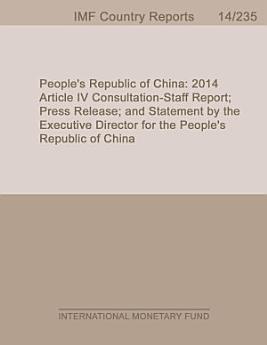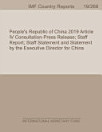People’s Republic of China: Staff Report for the 2014 Article IV Consultation
International Monetary Fund. Asia and Pacific Dept
Jul 2014 · International Monetary Fund
Ebook
115
Pages
reportRatings and reviews aren’t verified Learn More
About this ebook
KEY ISSUES Context. After three decades of remarkable growth, the economy has been slowing. Much of the slowdown has been structural, reflecting the natural convergence process and waning dividends from past reforms; weak global growth has also contributed. Moreover, since the global financial crisis, growth has relied too much on investment and credit, which is not sustainable and has created rising vulnerabilities. Growth was 7.7 percent in 2013, and is expected to slow to around 71⁄2 percent this year and decline further over the medium term. Focus. The pattern of growth since the global financial crisis is not sustainable and has resulted in rising vulnerabilities. The discussions focused on assessing the risks posed by the continued build-up of vulnerabilities; reforms to unleash new, sustainable engines of growth and reduce vulnerabilities; and how to best manage aggregate demand in this context, as growth is slowing yet risks are still rising. A key takeaway is that to secure a safer development path, accommodative policies need to be carefully unwound, accompanied by decisive implementation of the announced reform agenda to promote rebalancing. The result will be somewhat slower but safer growth in the near term, with the significant long-run benefit of securing more inclusive, environment-friendly, and sustainable growth. Risks. Credit and ‘shadow banking,’ local government finances, and the corporate sector— particularly real estate—are the key, and interlinked, areas of rising vulnerability. In the near term, the risk of a hard landing is still considered low as the government has the capacity to combat potential shocks. However, without a change in the pattern of growth, the hard-landing risk continues to rise and is assessed to be medium-likely over the medium term. Reform agenda. The authorities have announced a comprehensive and ambitious blueprint of reforms. Successful implementation should achieve the desired transformation of the economy, but will also be challenging. Demand management. Reining in credit growth, local government borrowing, and investment will address the risks, but also slow growth. Macro support should be calibrated to allow needed adjustments to take place, while preventing growth from slowing too much. Scenarios and spillovers. With faster adjustment and reform implementation, growth will be somewhat lower in the near term, with moderate spillovers for trading partners. However, in the medium term, income and consumption will both be higher—a result that is good for China and good for the global economy.
Rate this ebook
Tell us what you think.
Reading information
Smartphones and tablets
Install the Google Play Books app for Android and iPad/iPhone. It syncs automatically with your account and allows you to read online or offline wherever you are.
Laptops and computers
You can listen to audiobooks purchased on Google Play using your computer's web browser.
eReaders and other devices
To read on e-ink devices like Kobo eReaders, you'll need to download a file and transfer it to your device. Follow the detailed Help Center instructions to transfer the files to supported eReaders.








